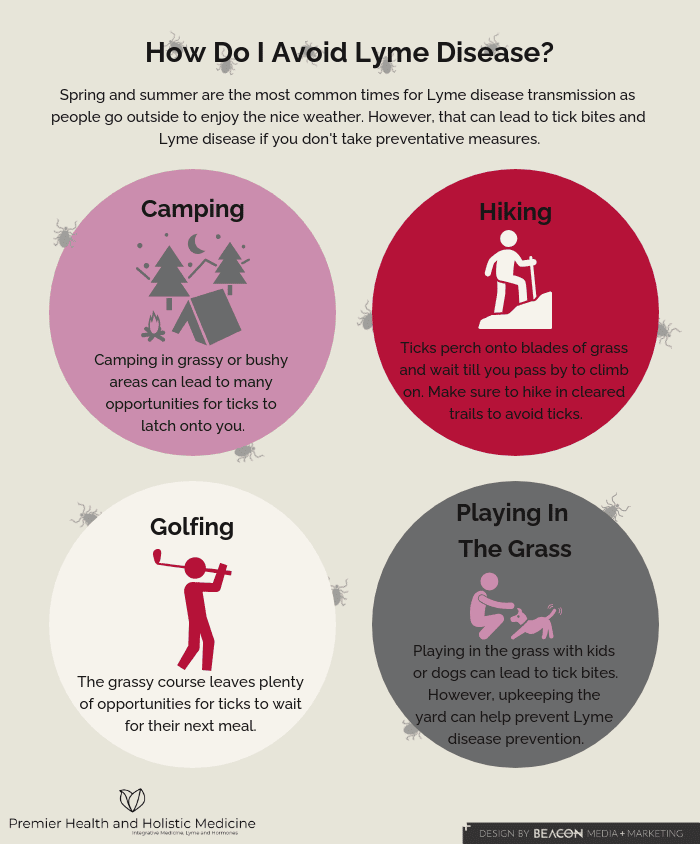Detecting Lyme disease can sometimes be challenging. Many of the symptoms share commonalities with flu-like symptoms. However, as time progresses, it can turn into prolonged or severe conditions.
Many people may use the common red bullseye rash that they get from ticks to indicate possible Lyme disease transmission. But some people don’t have the typical bullseye rash. And ticks tend to hide in hard-to-see places that can make it hard to spot when they’ve bitten onto you.
If you are experiencing prolonged flu-like symptoms like fever and chills, it may indicate Lyme disease. Here are some frequently asked questions that can help you recognize signs of Lyme disease.
Want to know what Lyme disease treatments we provide? Contact us today to learn more!
What Are Common Symptoms Of Lyme Disease?
Lyme Disease can sometimes be hard to spot. The first stages of Lyme disease have similar symptoms to the flu, including:
- Fever
- Chills
- Fatigue
- Headache
- Joint pain
- Muscle pain
- Swollen lymph nodes
It is easy to associate the symptoms with the flu or other illnesses in the early stages. However, if you’ve spotted a bullseye rash and have recently been outdoors in a grassy or bushy area, this can be an indication of Lyme disease.
If left untreated, the later symptoms can include more severe or longer-lasting symptoms. On top of the early stage symptoms, you may experience:
- Heart palpitations
- Dizziness
- Nerve pain
- Chronic fatigue
- Numbness in hands or feet
- Facial palsy
These symptoms may be worse at some times than others. The long-term symptoms may make your life a seemingly endless battle, which makes treating it so much more crucial.
Could a Fever And Chills Be Lyme Disease?
Fever and chills are one of the most common symptoms of Lyme disease. As your body tries to fight off the infection, you may experience common flu-like symptoms. This includes fever and chills as your body tries to create a temperature change to kill off the bacteria.
While these flu-like symptoms usually go away within a week of getting the flu, Lyme disease can persist for longer amounts of time. If you are still experiencing fever and chills that have lasted over two weeks, you should contact your doctor.
What Does Lyme Disease Feel Like?
The culmination of symptoms caused by Lyme disease can leave you feeling exhausted. And as the symptoms wax and wane, so can your exhaustion.
Migraines are another common symptom that may occur. These can hinder your ability to go on with your routine. Experiencing some of the symptoms will be physically tiring, so that you may feel chronically fatigued.
You may also notice a shift in your mental health. The physical symptoms may change how you go about daily life, making you feel like you’re not achieving as much as you used to. The physical and mental side effects can make you feel bad, so seeking treatment can help you return to your everyday life.
How Is Lyme Disease Transmitted?
Lyme disease is transmitted through ticks. When they feed on an animal with a bloodborne illness, it can infect them. The bacterium Borrelia burgdorferi will infect the tick and transmit to you if you are bitten.
No evidence shows that you can get Lyme disease through the air, food, water, or from the bites of mosquitos, flies, fleas, or lice. Dogs and cats can also get Lyme disease, but they can’t transmit it to you.
Ticks can be found in grassy or bushy areas, so it’s important to stay protected when going outside with clothing or insect repellent. Since ticks can’t fly or jump, they will wait on the blades of grass for you to pass by and climb onto you.
They will then find a spot to bite onto (typically hard-to-see areas). Some ticks release an antihistamine that can make it hard to feel when a tick has bitten you. In general, ticks have to be attached for 36 to 48 hours or more before the Lyme disease bacterium can be transmitted to you.
It’s essential to take preventative measures to avoid getting a tick bite. This can include checking your clothes and body once returning from the outdoors.
Has a tick bitten you? Schedule an appointment with us today to test for Lyme disease.
Where Is Lyme Disease Most Common?
Lyme disease is common in areas with grassy or bushy environments. This includes nearly all the United States, Europe, and Asia. The Northeast, upper Midwest, and Northwestern states of the U.S are the most common areas.
If you have a dog and live in these regions, make sure to check their fur and take preventative measures, so they don’t get sick. Checking them before they come inside can also keep your dogs from bringing ticks into the house.
It would help to upkeep your landscape in these areas to ward off ticks in your yard. This can keep you, your pets, and your children safe.

When Is Lyme Disease Season?
Although ticks are present year-round, the warmer seasons are the most common times for Lyme disease transmission. The spring and summer seasons welcome people to go outside. While they’re enjoying their favorite outdoor activities, these are the most prevalent times for ticks to latch onto you.
Some activities that could potentially have you crossing paths with ticks include:
- Camping
- Hiking
- Golfing
- Playing in grass
When enjoying these activities, it’s a good idea to take preventative measures to avoid tick bites. Try to stay on cleared paths and avoid going through thick brush and grass.
Can Lyme Disease Be Cured?
Although the long-term symptoms of Lyme disease can be scary, treatments are easy to get. Some people may even get over the disease themselves.
Most people will treat their Lyme disease with antibiotics that can cure it anywhere from two to four weeks. However, some may experience longer treatments for up to six months if they reach the later stages of Lyme disease.
With antibiotics or holistic treatments, you can get rid of your Lyme disease and return to your everyday life.
How Can Premier Health And Holistic Medicine Help My Lyme Disease?
At Premier Health and Holistic Medicine, Dr. Robin Ridinger takes a holistic approach to Lyme disease treatment. She wants to address your overall health and how your body systems interact with one another.
Dr. Ridinger will create a personalized treatment plan that fits your needs when you come in. Treatment plans can include:
- Detoxification so your body naturally gets over the disease.
- Diet and supplements since food fuels your body.
- Thyroid replacement therapy to help the hormones in your body.
- Adrenal support can help your physical and mental wellbeing.
- Bioidentical hormones that will aid your body in defeating the disease.
- Herbal therapies that are potent to the Lyme disease bacteria.
- Antibiotics or antifungals if needed.
Although Dr. Ridinger prefers a holistic approach to curing your Lyme disease, she will do what is best for you. After choosing a method, she will monitor your results and adjust your treatment to ensure a healthy recovery.
If you suspect that a tick has bitten you and you’ve contracted Lyme disease, it’s essential to seek treatment from a doctor. Before your symptoms may worsen, go test for Lyme disease and find a treatment plan that is best for you.
Want to take a holistic approach to cure your Lyme disease? Schedule an appointment with us today!


